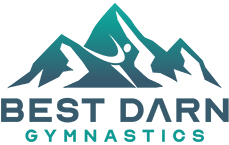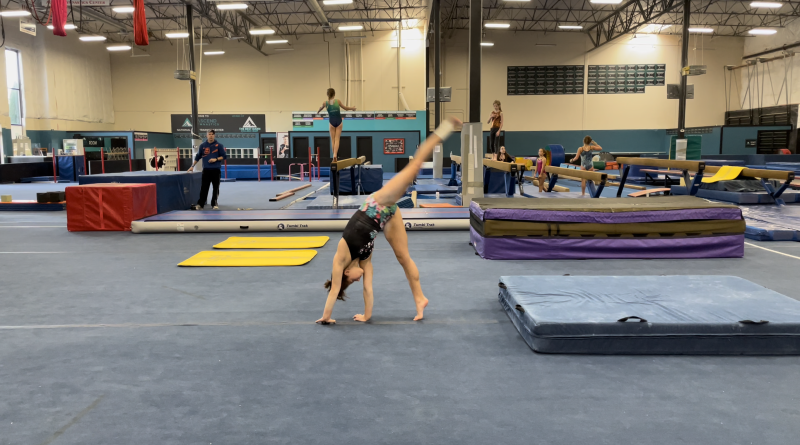The Cartwheel Step-in
This is an example of a cartwheel step-in to coil. The pieces of the skill will be broken down in each of the subsequent pictures/steps.
Double Leg Lunge
The hurdle position is important and there are many concepts and philosophies as to what it should look like and why. We like to teach the hurdle to a double leg lunge position with the hands, shoulders, hips and back leg knee in general stacked vertical alignment. The purpose of this position is to make sure that the athlete stays on balance through the hurdle and doesn’t create a large lean and therefore a shift of weight to an off-balance forward lean. Most often when athletes lean far forward and reach super early, they end up lifting the back leg prior to the hands getting to the floor and therefore they lose some of their power available in their legs to push off for turnover.
Look Under the Armpit
From the hurdle, we ideally will see a strong quarter turn to straddled handstand. When in the handstand position, we ask that the athletes look under their armpit to see where they are going and the location to which they will snap their feet. We encourage parallel hands as much as possible and though you see this athlete has her hands offset slightly, on the line, you do not see the second hand turned completely back towards the first hand. In general, the more the athlete tries to turn that second hand back towards that first hand, we see an overturn of the shoulders and subsequently a more inefficient turn.
First Foot Stays Close
The goal for the turnover of a cartwheel or roundoff is to get the feet to the floor as fast as possible. As we teach the cartwheel step-in, we ask our gymnasts to snap their first foot down fast and close to the second hand. The body acts much the same as a slinky and can only truly work one action at a time. It cannot both snap down and lift up simultaneously. We don’t want lag between the hands and feet contact and we don’t want distance, so we drill fast and short. Prioritize the feet snapping down before doing any sort of hand, arm, chest, lift.
Second Foot Snaps In – Hands Stay Down
As the second foot snaps in, the hands should stay pointing at the spot that they left the floor. If the body is tight, as the feet snap in, the chest should lever up slightly. There is no need to lift or open the shape. Snap under and leave the hands waiting for the moment of contact and rebound so the body can stay loaded until uncoil is needed.
Loaded Bow and Arrow
When you shoot a bow and arrow for maximum power and projectile speed, you pull the bow string back to the farthest point possible. You maintain this tension on the string until it is time to shoot the arrow. We train the coil position with the same concept in mind. Leave the hands pointed, snap the feet and create a tight coil to the floor. Gymnast holds this coiled shape until the desired punch. Then they can “release the bowstring” and uncoil as fast as possible to create turnover/reach for the next skill. This coil shape should maintain an even bend of the hips, shoulders and essentially trying to create one curved line along the whole body. No angles or broken lines. This allows for the use of all the muscles along the back of the body (shoulders, lats, mid-back, glutes, hamstrings) to fire at the same time to increase the efficiency of the shape change.

